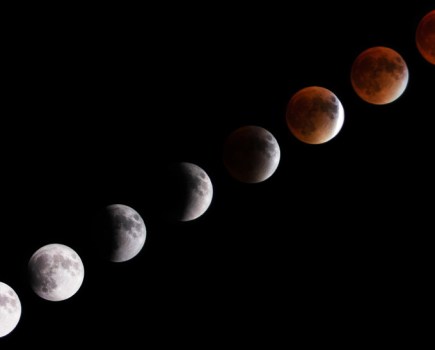Want to give your pictures more oomph? Nigel Atherton shares a few tips
In a world saturated with imagery, your pictures have just a couple of seconds to make an impact.
It could be that the subject itself is so striking that it begs to be seen and admired, but these occasions are few and far between. Most of the time it’s down to the photographer to work a little harder to sprinkle a touch of magic dust and create something special.
Luckily, there are many ways to do this, from the use of light to the choice of composition. Here are a few ideas.

Adding impact: Add foreground interest
Pay attention to what’s in the foreground as well as the background.
Also, seek out, wherever possible, viewpoints that provide something interesting to look at in both zones.
In this scene, the camera has been framed to make a foreground feature of the receding tide.
 Adding impact: Look for natural frames
Adding impact: Look for natural frames
Try providing a natural frame for your subject.
For example, try shooting through tree branches, an open doorway, a window or a colonnade.
These act like barriers, preventing the viewer’s eye from wandering off out of the frame and pushing the gaze back into the centre of the image.
Adding impact: Use lines to lead the eye
Our eyes naturally follow lines in images – and in the real world – to see where they lead us.
We can use this knowledge to take the viewer’s eye from the edge of the frame into the centre of your image, or to its main focal point.
Adding impact: Look for interesting details
 It’s the little things that often make the most interesting pictures.
It’s the little things that often make the most interesting pictures.
While a wide view of an autumnal forest may make a great shot, a more graphic image of a single fallen leaf could have more impact.
To spot these opportunities, you just have to take the time to look around.
You have to be open to the possibilities that present themselves to you.
Adding impact: Choose a high or low viewpoint
Most pictures are taken from eye level.
Because of this, shooting from low down automatically captures the viewer’s attention.
This has the effect of emphasising the foreground or the height of a subject.
From high up, or low down, you can often see patterns and shapes that aren’t apparent from ground level.
Experiment with different viewpoints to see which level creates the best shot.
Adding impact: Create colour compositions
Colour needn’t be incidental in your shot, it can be the subject itself.
Images with a dominance of a single colour often work well.
This is especially the case if the image also includes a dash of its complementary colour to provide a contrast.

Adding impact: Create a shallow depth of field
One of the most effective ways to draw attention to a particular element in an image is through selective focus: making one element sharp while everything around it is blurred.
This effect is known as a shallow depth of field.
This can be used to isolate a face in a crowd or a single bloom in a field of flowers.
It is achieved by selecting a wide aperture (such as f/2.8), or using longer telephoto lenses.
Getting in close also helps produce the effect.
Due to their wider lenses, shallow depth of field is difficult to achieve with compacts.
Adding impact: Shoot into the sun
Shoot into the light for added atmosphere.
However, you should hide the sun itself just out of shot or behind the subject.
Backlighting, or contre jour, creates a lovely halo around solid objects.
This technique also makes translucent subjects, like flower petals, glow.
Adding impact: Focus on patterns
Patterns occur frequently in nature such as in the spots on a leopard, the bark on a tree, the arrangement of pebbles on a beach.
They also occur in in man-made subjects such as architecture, or the furrows of a ploughed field.
Patterns are frequently created by light and shadow.
Wherever they occur they can make very powerful images.
 Adding impact: Zoom in on reflections
Adding impact: Zoom in on reflections
Reflections are like a ‘two for the price of one’ deal – you not only get the subject but a mirror image, too.
This is one of the few occasions where its okay to put the horizon across the middle of the frame.
Alternatively, or you could exclude the subject altogether and just photograph the reflection for a slightly surreal image of the object itself.
Adding impact: Focus on shadows
Shadows are among the most photogenic of subjects, whether you include the object that’s casting it or just focus on the shadow itself.
In order to get interesting shadows you do need a sunny day.
However, it’s much better to shoot in the early morning or late afternoon when the sun is lower and the shadows are longer.
Winter is a great season to try this technique because the sun is lower in the sky anyway.
Adding impact: Get closer to your subject
If your portraits lack impact, the chances are you’re too far away.
Make sure your subject isn’t stranded in a sea of uninteresting background.
Unless the surroundings contribute to the story, crop them out.
Don’t be afraid to go in close on a subject’s head and shoulders.
Also, remember to focus on the subject’s eyes.
Adding impact: Go out in the rain
 Most people save their photography for dry days but there’s often more drama to be captured when it’s stormy.
Most people save their photography for dry days but there’s often more drama to be captured when it’s stormy.
Dark clouds, heavy rain, fog and other inclement conditions can be very photogenic and you’ll probably be the only one who gets that great shot.
If you’re lucky you might even see a rainbow.
But make sure your camera is protected.













